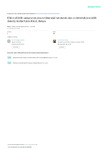Effect of drift sampler exposure time and net mesh size on invertebrate drift density in the Njoro River, Kenya
| dc.contributor.author | Mureithi, Priscilla W | |
| dc.contributor.author | Mbaka, John Gichimu | |
| dc.contributor.author | M’Erimba, Charles M | |
| dc.contributor.author | Mathooko, Jude M | |
| dc.date.accessioned | 2019-08-22T06:53:57Z | |
| dc.date.available | 2019-08-22T06:53:57Z | |
| dc.date.issued | 2018 | |
| dc.identifier.issn | 1727-9364 | |
| dc.identifier.uri | http://ir.mksu.ac.ke/handle/123456780/4762 | |
| dc.description.abstract | Although invertebrate drift is an important ecological process in lotic ecosystems, very little is known about it in Kenyan rivers. The primary aim of this study was to investigate the effect of driftnet mesh size and exposure duration on drift density in 2017. Drift samples were dominated by Chironomidae, Baetidae, Simuliidae, Caenidae and Culicidae. The 100 µm mesh driftnet had the highest mean invertebrate density, followed by the 250 µm and 500 µm nets. Invertebrate drift densities decreased with increased exposure time. This study demonstrates that sampler mesh size and exposure time should be taken into account when characterising inve | en_US |
| dc.language.iso | en_US | en_US |
| dc.publisher | Taylor & Francis | en_US |
| dc.subject | Lotic ecosystems | en_US |
| dc.subject | Macroinvertebrates | en_US |
| dc.subject | Nakuru County | en_US |
| dc.subject | Rriffle habitats | en_US |
| dc.title | Effect of drift sampler exposure time and net mesh size on invertebrate drift density in the Njoro River, Kenya | en_US |
| dc.type | Article | en_US |
Files in this item
This item appears in the following Collection(s)
-
School of Environment and Natural Resources [101]
Scholarly Articles by Faculty & Students in School of Environment and Natural Resources

